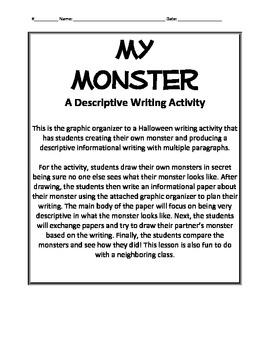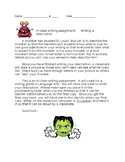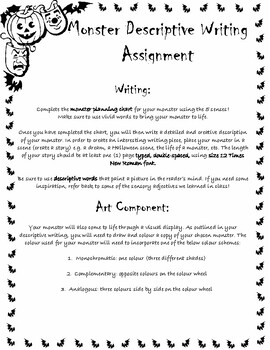Monster Descriptive Writing
Have you ever tried writing about monsters but struggled to bring them to life on the page? Monster descriptive writing can be a challenging but rewarding task for writers. Capturing the essence and personality of a made-up monster can be difficult, but it's a crucial skill for anyone interested in writing horror, fantasy, or science fiction. In this post, we'll explore the art of monster descriptive writing and share tips on how you can improve your skills in this area.
The Challenge of Monster Descriptive Writing
When you're writing about monsters, there are a few challenges you may face. Firstly, it can be tough to create a creature that is both unique and believable. You'll need to strike a balance between inventiveness and realism to create something that truly feels like a living, breathing monster. Additionally, you'll need to use language effectively to capture your monster's essence. Words like "fearsome," "terrifying," and "monstrous" can help convey the emotions you want your readers to feel when they picture your monster.
What is Monster Descriptive Writing?
Monster descriptive writing is a fascinating and challenging art that requires writers to use language creatively to capture the essence of a made-up creature. The target of monster descriptive writing is to create a clear mental image of your monster in your reader's mind. A strong descriptive passage can be incredibly evocative and make your fictional monster feel like a real, breathing creature. To achieve this, you will need to use descriptive language that helps you create a vivid picture of your monster. Descriptive writing also requires you to think about your reader's emotions and what they might feel when reading your work.
Master the Art of Monster Descriptive Writing
If you want to master the art of monster descriptive writing, there are a few tips you can follow. Firstly, try to focus on the details of your monster. Think about what makes it unique and how you can convey its personality through language. You should also try to think about how your reader might feel when they encounter your monster. This can help you create a stronger emotional impact in your writing.
You should also experiment with different writing techniques to bring your monster to life on the page. For example, try using metaphors or similes to describe your monster. This can help make your writing more evocative and memorable. You could also try using vivid, sensory language to create a more immersive reading experience.
The Importance of Editing and Revising
As with all forms of writing, editing and revising are crucial when it comes to monster descriptive writing. After you've finished your first draft, take the time to go back through your work and look for areas where you can improve. Remove any unnecessary or repetitive details and focus on making your language as descriptive and evocative as possible.
One useful exercise is to read your work out loud to yourself. This can help you identify areas where your language feels clunky or awkward. You could also ask a friend or colleague to read your work and provide feedback. This can help you get an outside perspective on your writing and identify areas where you can improve.
Question and Answer
1. How can I make my monster feel more realistic in my writing?
To make your monster feel more realistic, you should think about its physical characteristics and how it would behave in the world you've created. Try to use descriptive language that helps you convey your monster's personality and emotions.
2. What techniques can I use to make my monster more terrifying?
To make your monster more terrifying, you could experiment with using sensory language to create a more immersive reading experience. You could also use metaphors or similes to describe your monster in a way that evokes feelings of fear and terror.
3. Is it important to establish rules for my monster?
Establishing rules for your monster can be helpful, as it can help make your creature feel more believable and grounded in the world you've created. However, you should also be willing to break these rules if it helps you create a more interesting or evocative story.
4. How can I use dialogue to bring my monster to life?
Dialogue can be a powerful tool for bringing your monster to life, as it allows you to give your creature a voice and personality. Try to think about how your monster would speak and what kind of language it would use. You could also experiment with using different dialects or accents to give your monster a unique speech pattern.
Conclusion
Monster descriptive writing can be a challenging but rewarding task. By following the tips outlined in this post and experimenting with different writing techniques, you can master the art of creating believable, terrifying, and memorable monsters on the page. Happy writing!
Gallery
Descriptive Writing - Monster Match - SSSTeaching

Photo Credit by: bing.com / monster writing descriptive match
My Monster: A Halloween Descriptive Writing Activity By A Ruffo | TpT

Photo Credit by: bing.com / descriptive monster writing halloween activity paragraph grade graphic activities organizer organizers teacherspayteachers choose board
Descriptive Writing Monster & Worksheets | Teachers Pay Teachers

Photo Credit by: bing.com / descriptive
Descriptive Writing - Monster Match | Descriptive Writing, Descriptive

Photo Credit by: bing.com / descriptive sssteaching
Descriptive Writing "Monster" Assignment By The SimPal Classroom

Photo Credit by: bing.com / descriptive monster writing assignment